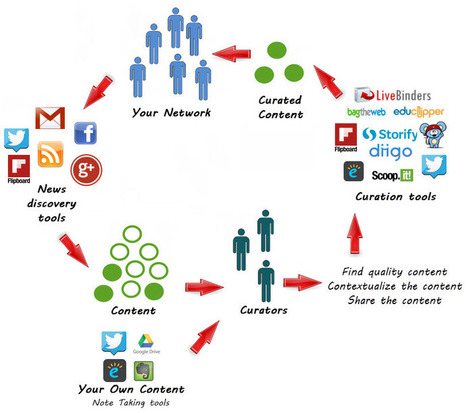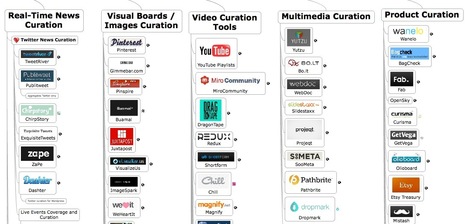Research and publish the best content.
Get Started for FREE
Sign up with Facebook Sign up with X
I don't have a Facebook or a X account
Already have an account: Login

What a Content Curator Needs To Know: How, Tools, Issues and Strategy
Curated by
Robin Good
Author: Robin Good

 Your new post is loading... Your new post is loading...
 Your new post is loading... Your new post is loading...
Bob Boynton's comment,
March 31, 2014 12:51 AM
I cannot use my scoop.it because I am following you and I do not have adobe flash installed, and I do not want adobe flash installed. But the video will not let me access my scoop.it.

socialcompany's curator insight,
May 23, 2014 9:04 AM
stories behind circa, inside, newsy, good short videos.

Robin Good's comment,
June 25, 2012 8:27 AM
Thank you Terry for reporting this: "the video is now private"
What do you make of it? Do you think it would have been better for the authors to provide a feedback or a comment to these issues rather than closing down the video for everyone? In a situation like this, what is more appropriate to do, in your view? Take down the material that may have some disputable parts, or discuss openly the issues with everyone while fully acknowledging possible overlooks and mistakes? 
Terry Elliott's comment,
June 25, 2012 8:45 AM
Robin, I actually went to Jane Hart's Social Learning Centre site (http://sociallearningcentre.co.uk/) and registered thinking that I had to be a member-still private. Then I joined the group that was based upon the webinar (http://sociallearningcentre.co.uk/groups/in-conversation-with-david-kelly-webinar/). No joy--still private. I left a comment on the video asking for help, but it has only been a short while.
I suppose what anyone makes of it depends upon how much slack is deserved. Jane Hart has been a serious asset in my search for answers to social media questions especially lately with her work at Internet Time Alliance, but... 1. Perhaps they realized that the webinar was a bit off the cuff. Half-baked might be less charitable, but I don't know because it's PRIVATE. I cannot make my own judgment and that is not good. 2. It might be painful, but sunlight is always best in public conversation. I would not take down the disputed parts but rather view them as starting points for another webinar 3. Don't you think they are missing a wonderful opportunity to drive traffic to their site? I do. It isn't too late. I would love to follow that, perhaps a Hangout on Air? I am working with a study group on P2PU that will open a discussion of curation for the National Writing Project's Digital Is network that is considering some of what you have already spoken to (https://p2pu.org/en/groups/curating-our-digital-lives/). Our goal is teacher-centered curation and I know my teaching fellows would value this conversation. Hell, we might just have it ourselves. I don't think you are wrong in your critique but without a public conversation we will never really know for certain, will we. Perhaps it would be a dialectic and a grander truth than yours or Kelly's would evolve from it. 
Robin Good's comment,
June 25, 2012 9:03 AM
Terry, I couldn't agree more with your excellent comments and thoughts.
I second them all and you have all of my support in promoting them. Thank you. |

Beth Kanter's comment,
May 6, 2014 1:27 PM
Thanks for scooping the post - and modeling good content curation skills ...
1.) changed headline (way better than the original) 2.) Photo to illustrate headline 3.) Summarized the key points 4.) Added additional links from the source 5.) Shared it through channels 
Robin Good's comment,
May 6, 2014 1:32 PM
Thank you Beth, hehe. It was meant to be "in the ocean", but then I found that great picture and decided to move onto "sand".
Thank you so much for referencing my work and for highlighting, as we all must learn to do more often, the good stuff you found in it. 
David Collet's curator insight,
May 6, 2014 11:24 PM
I like this.
Long ago, in a former life, I used to get newspaper articles passed to me each day that were relevant to my job and/or my aspirations. I would take the necessary hour or so each day to remain current with world affairs related to what I did or where I wanted to go.
Curation is a lot like that except it is more global in concept.
This article talks about how to do this in the best way.

trendspotter's comment,
August 9, 2013 9:42 AM
Since Flipboard launched on the web the audience of my Flipboard magazine ( http://flip.it/7dXbs ) has grown from 1000 people to 8000 people. So for me this was a huge shift.

Robin Good's comment,
August 9, 2013 10:00 AM
Thank you Trendspotter for sharing this valuable info. Much appreciated indeed.

trendspotter's comment,
August 14, 2013 12:00 PM
To be fair. First the CEO of Flipboard had added my Future magazine to his personal list of his favorite magazines. Then some weeks later the team at Flipboard added my magazine in their new overview of officially recommended Flipboard user magazines, where I'm still listed here (https://flipboard.com/magazines/#tech-science) that is when my readership grew to 8000 people. Now I've noticed that my magazine is also showing up in the recommended list of tech magazines in the Flipboard app, next to large media sites like Ars Technica or Giga OM or TNW. That is when I grew to 10.000 readers.
So my point is: Flipboard starting the web version was not the only effect why I got so many new readers there. Basically the reason was their promotion of my magazine, which started when they started their web version.

Mike Ellsworth's comment,
October 10, 2012 10:23 PM
Mala, thanks for the reScoop and many thanks to Robin Good for the crazy good mindmap!

Mike Ellsworth's comment,
October 10, 2012 10:23 PM
Mala, thanks for the reScoop and many thanks to Robin Good for the crazy good mindmap!
sanhdyuhjue's curator insight,
January 4, 2013 8:23 PM
Hello there, You have done an incredible job. I will definitely digg it and personally suggest to my friends. I am sure they’ll be benefited from this web site.<a href="http://downjustforme.com/"; rel="dofollow">is this site down</a>
|












An absolutely significant skill in any research or investigation, for educators and learners in the digital age - the curation of content- with a clear focus or question in mind, the capacity to target a search field, sift through, reflect on and make decisions about the most suitable resource or evidence to use. What a great learning experience.
Forstå og komme i gang med kurator tjenester.